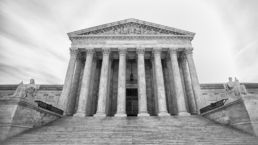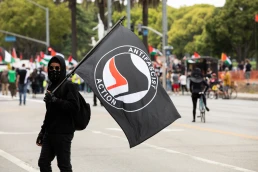CounterSpin interview with Liliana Segura on Supreme Court v. innocence
By Janine Jackson, FAIR.org
Janine Jackson interviewed Liliana Segura about the Supreme Court and innocence for the June 3, 2022, episode of CounterSpin. This is a lightly edited transcript.
Janine Jackson: “Innocence is not enough” are words to chill your heart. That’s the language Arizona state prosecutors used as a reason not to revisit the conviction of Barry Lee Jones, after the Ninth US Circuit Court of Appeals determined that Jones had not received effective counsel, and that if he had, his jury would likely not have convicted him of the murder of his girlfriend’s four-year-old daughter.

And the Supreme Court agreed this week. They voted six to three, in a case called Shinn v. Martinez Ramirez, that incarcerated people, including death row inmates like Jones, have no right to bring new evidence in their claims of ineffective lawyering in federal court, even if that evidence would show they’d committed no crime.
Sonia Sotomayor called the ruling “perverse” and “illogical”; experts like Christina Swarns, head of Innocence Project, noted that ineffective assistance of counsel is a leading cause of wrongful conviction. And it was lost on few that the same judges who insist that the sanctity of life demands that fetuses mean more than the people carrying them show no evidence of such interest here.
Pretty much any deep account of this court ruling will cite the work of our guest. She has been reporting criminal justice and the death penalty for many years, and was writing about Jones’ case in particular back in 2017. Liliana Segura is a reporter at the Intercept. She joins us by phone from Nashville. Welcome back to CounterSpin, Liliana Segura.
Liliana Segura: Thank you so much for having me.
JJ: Can I ask you to talk us through the key points of the case against Barry Lee Jones, and the issues with that case, such that it wound up at the Supreme Court?
LS: Absolutely. So Barry Jones was convicted in 1995 of the rape and murder of his girlfriend’s four-year-old daughter, Rachel Gray. Rachel was living with her siblings and their mom in Jones’ trailer, at a place called the Desert Vista Trailer Park in Tucson. This was a place where there was pretty pervasive poverty and drug use, and a lot of folks sort of living on the margins.
And what happened was that on the morning of May 2, 1994, Rachel was found unresponsive in her bed at Jones’ home, and Jones and Rachel’s mom rushed her to the hospital, where she was declared dead on arrival. There were some disturbing signs of injury all over her body.
But crucially, an autopsy, which was not performed until the following day, found that Rachel had died from an apparent blow to her abdomen that had torn part of her small intestine. And this led to a fatal injury called peritonitis.
But also crucially, from the start, the investigating detective with the Pima County Sheriff’s Department never looked into exactly how Rachel had sustained this injury. There was no real investigation of that key medical evidence. Instead, before they even knew how this little girl died, she turned her sights directly onto Barry Jones.
So if you fast forward, Jones was tried in 1985. There should have been a lot of evidence that his trial lawyers could have brought to cast doubt on his guilt in this case. There was really no physical evidence, or very little physical evidence, linking him to Rachel’s injuries, and especially important was the fact that the case was really based on circumstantial evidence, a very narrow timeframe on the day before this little girl died where she had been spotted with Jones by people around the trailer park. And so the state presented a case in which her fatal injury had been inflicted within this very narrow timeframe, the day before she died.
Now, Jones’ trial attorneys should have investigated this; they should have talked to somebody who could consider the medical evidence to see if this held up. But, instead, they never did that. And, in fact, they really failed to investigate the case at all. And instead, when it came time for them to present evidence, they put on a single witness at the guilt phase, and that was Jones’ 12-year-old daughter, Brandie. That was their only witness.
So Jones’ jury finds him guilty, and a judge sentences him to death.
JJ: And then there’s an appeal, which, again, there’s another problem. That’s part of the issue here, is there’s a couple of layers of ineffective lawyering, right, before it makes it up to the Supreme Court.
LS: That’s exactly right. So, in our system, at least in theory, after you are convicted, and certainly sentenced to death, you have the right to bring forward an appeal. And, crucially, you have a right to bring evidence that your trial attorneys failed you, that they provided ineffective assistance of counsel.
This is a really important avenue for relief, especially for people on death row, because it’s that kind of evidence that can lead to a conviction being overturned, or somebody being exonerated. The problem is that there’s absolutely no guarantee that your lawyer who handles that appeal is going to do what they need to do.
And in Barry Jones’ case, this is precisely what happened. He was represented at state post-conviction by a man who basically replicated the same mistakes his trial lawyers made. He did not investigate the medical evidence underpinning the state’s case against Barry Jones.
And what’s so significant about that failure is that, because of the way that our system is set up, and these incredibly onerous procedural barriers that exist once a case is at that stage, once a post-conviction attorney fails to bring forward that evidence of bad lawyering, you can never bring that evidence into federal court at a later stage. It’s basically barred.
And so that’s what happened to Barry Jones. Until—and this is what leads us to the Supreme Court situation—in 2012, the US Supreme Court handed down a really important ruling in a different Arizona case, and this ruling was called Martinez v. Ryan. And in this ruling, in a 7–2 decision, the court held that, essentially, if you had a situation, as with Barry Jones’ case, where your trial lawyers failed you and then your state post-conviction lawyers also failed you, that you should actually have a shot to bring forward this claim, to bring forward, potentially, evidence to prove that you received ineffective assistance at trial.
This was a really big deal when it came down in 2012. But it was meant to be a narrow remedy, a sort of safety valve, precisely to avoid miscarriages of justice, and to ensure that people on death row and people incarcerated are able to vindicate their Sixth Amendment rights.
And this ruling was also really noteworthy because Chief Justice Roberts was in the majority. So was Sam Alito, it bears mentioning. So 7–2, this is 2012. And it’s ultimately that decision that allows Barry Jones to bring forward all this evidence that should have been brought forward in 1995 at his trial.
JJ: Thank you very much. This latest, Shinn vs. Martinez Ramirez, seems to be gutting that Martinez ruling that you’re talking about. It’s this weird thing, and folks can learn more about it, but as I understand it, writing for the majority, Clarence Thomas is saying, You can still bring your case about having ineffective counsel to federal court, you just can’t introduce any new evidence, which presumably would be the stuff, as you’re just explaining, that your ineffective counsel left out.
So I’ve heard this new ruling described as hollowing out Martinez without actually explicitly overturning it, but still taking all the meaning out of it.
LS: That’s precisely right. And it really bears mentioning, first of all, that Clarence Thomas was in the minority in Martinez. So he never agreed with this decision to begin with. But, you know, all of this sounds bad, but it’s sort of theoretical until you consider what this looks like, for example, in Barry Jones’ case.
What this means is that, as I said, in 2012, Barry Jones gets this new door to be able to present his evidence. He finally is able to do that at an evidentiary hearing in federal court in 2017. I attended part of this hearing; this was the start of my reporting. And it was at that hearing that Barry Jones’ lawyers present just an incredible wealth of evidence pointing to his innocence. Technically, what they needed to show was ineffective assistance of counsel, but it really just dismantled the entire case against Barry Jones.
And it was stunning to watch the judge presiding over this; at times, he would question law enforcement who took the stand, saying, “Well, didn’t you consider this?” or “Why didn’t you consider any other suspects?” The case really sort of fell apart. And in 2018, this federal judge overturned Barry Jones’ conviction, and said that, but for the failures of his defense attorneys, he would not have been convicted by a jury, and he ordered a new trial. And he said, essentially: The state of Arizona, you have to release or retry Barry Jones.
And instead, the state of Arizona appealed and appealed and appealed. Once the Ninth Circuit, lost there, went back to the Ninth Circuit, lost there again. But then you get the Supreme Court, and they took their shot. And they got lucky, because now we have this conservative supermajority at the Supreme Court that was willing to listen to their arguments.
JJ: And to say, as Thomas said, “intervention,” in other words, introducing the information that can prove or illustrate that this person may not have committed this crime, or did not commit this crime—”intervention is an affront to the state and its citizens who returned a verdict of guilt after considering the evidence before them.” In other words, states’ rights? Is that what we’re talking about here? It’s a process question, and it’s insulting for the federal court to intervene in this case? That seems to be the load-bearing idea in Thomas’ opinion.
LS: Exactly. And this goes back to a long argument on the right, about basically insisting that federal courts really have no business messing with the outcomes in state proceedings. And this long precedes Barry Jones’ case, but it’s really disturbing to see it in this way.
And also, that particular line that you mentioned is especially ironic to me, because, as part of my reporting, I got in touch with some of the jurors involved in Barry Jones’ case, who expressed serious misgivings about this whole situation. And one in particular came to believe that Barry Jones is absolutely innocent, and she died in the past couple of years, but in our correspondence, in our interview, she was just really tormented by her role in helping send Barry Jones to die.
So this idea that it’s an affront to the citizens to return to this verdict, it’s just so dishonest.
JJ: I want to add something here, because details matter very much, of course, and I think, at the same time, they can also fill this sort of human need to find exceptions, to find a reason this would never happen to you, to find a way that this makes sense even though it doesn’t really make sense, because system failure, I think, is just hard for our brains to grasp. And so, in some sense, details can fight with principle.
And with that in mind, Ramirez—there’s a reason that Ramirez appears in this case name, and the Ramirez case is different. It’s not about innocence, but it’s still about inadequate counsel. And it’s still about federal involvement showing multiple failures that had happened at the state level. Can you just tell us quickly why the Ramirez case fits here?
LS: Yeah, and I’m glad you bring this up, because this is a question of innocence. But in Ramirez’s case, it is a lot more difficult for a lot of people to express concern about, but it should be no less disturbing in terms of the implications of this ruling.
Ramirez—and I should say, I have not reported on his case—but the basics are that he was convicted of murdering his girlfriend and her teenage daughter in 1989. He did not have an innocence claim, but he did have, I understand, significant mental impairments, and a long history of childhood trauma, abuse and neglect. All of these things are very common among people who end up on death row. And Ramirez’s lead trial attorney had never handled a death penalty case, did not investigate any of this evidence. And as with Jones, his post-conviction lawyer essentially failed to do the same.
And so it makes its way through the courts. But essentially what happens is that there’s a finding in federal court that he’s entitled to an evidentiary hearing in light of Martinez, in order to bring forward this evidence, which is the kind of evidence that can also help a person get off of death row, because, ostensibly, we’re not supposed to execute people where there should have been a significant finding of childhood trauma, abuse and neglect that could have come out at trial, during the course of what’s called “mitigation.”
Essentially, if there had been evidence that jurors had heard that might have moved them to vote differently, that should have come out. Same thing with intellectual disabilities and other kinds of mental problems.
Again, because these are such common characteristics of death penalty cases, Ramirez, in many ways, represents a lot of the same stakes that men and women on death row have, and Martinez should have really allowed them to get back into court to present these findings. And instead, as with Jones, the court said, You know what, none of that matters. And if the evidentiary hearing already happened, too bad, none of it counts.
JJ: Ramirez’s lawyer said that she “wasn’t prepared to handle the representation of someone as mentally disturbed” as he was. And I think, just as laypeople, we think that should have meaning.
It’s hard not to read something into the careful carelessness of this ruling. It looks like emphasis on procedure over people, but it seems really like emphasis on some people over others. Shoring up state power helps certain kinds of people. And it’s hard to avoid the idea that there’s a sense that the people who are being harmed here are just of “the harmable class,” and that there’s some reason that we shouldn’t care about them.
And I think for many people, thinking about people ends once you say the words “death row.” There is a sense that they’ve been through all the process, they’ve been found guilty, they must be guilty of something. And you’ve been working on that story and those people for a long time. I just think that there can never be enough reporting on the realities of the death penalty, and the people that are involved there, because I think for a lot of folks, it’s a thought-stopper.
LS: Thank you for saying that. One thing that’s sort of surreal about this whole situation, in most cases like this, by the time the case gets to the Supreme Court, a lot of these issues become abstractions, you know? It’s very rare that we know the story behind the people who appear in these court case names, and in Barry Jones’ case, I never would have predicted that this would have ended up making it all the way to the Supreme Court.
But it shows the difference that this kind of storytelling can make, when you can say, this is a human being, and here are the people in his life who knew him and who remember this, and who could’ve brought forward evidence, and continue to speak out about the problems in this case.
So I’ve been fortunate to be in a position to correct parts of the record. Unfortunately, in terms of the Supreme Court and the federal court, that road has really come to an end for Barry Jones for the moment.
JJ: Let me just ask you, finally, I’ve seen a few things—”go to Congress.” What do you see as ways forward here, along with continued reporting, such as you’re doing?
LS: That’s sort of what I’m figuring out now. In terms of Congress, well, I don’t have a whole lot of hope, but I will say that this has sparked yet another round of discussion about this horrible 1990s-era law called the Antiterrorism and Effective Death Penalty Act, which was essentially weaponized in this case to deny relief, as it’s been denied to many, many people on death row. This law is insidious, it’s destructive, it really should be repealed. That’s something that is an evergreen subject among people who know this issue.
And more in terms of Barry Jones’ case, my next steps are essentially to see what remaining avenues there are for him to bring, possibly, an actual innocence claim in state court. Because otherwise, we’re talking at a time when Arizona has restarted executions after eight years, and there’s a very real danger that Barry Jones could, in the not-too-distant future, end up with an execution date. So I think publicizing this case, especially at the local level and Pima County, is going to be very important.
And finally, there’s a Conviction and Sentencing Integrity Unit in Pima County that, at least in theory, should be looking at this case, and up until now, they haven’t been. I’m really hoping to see if that’s a possibility going forward, because they really should be looking at it.
JJ: Thank you very much. We’ve been speaking with Liliana Segura. Find her work at TheIntercept.com, on this case and many other issues. Liliana Segura, thank you so much for joining us this week on CounterSpin.
LS: Thanks so much again.
Recent Posts
Elon Musk Is Vowing Utopia Driven by AI and Robotics. Bernie Sanders Has a Few Questions
December 20, 2025
Take Action Now “I look forward to hearing about how you and your other oligarch friends are going to provide working people with a magnificent life…
U.S. Military Willing To Attack “Designated Terrorist Organizations” Within America, General Says
December 19, 2025
Take Action Now “If I had no concerns and I was confident in the lawful order, I would definitely execute that order.”By Nick Turse, The……
DOJ Won’t Meet Friday Deadline To Release All The Epstein Files
December 19, 2025
Take Action Now The delay means the White House is in apparent conflict with a law President Donald Trump signed in November.By Gregory…
Privatize USPS? Mail Carriers Have A Better Idea
December 18, 2025
Take Action Now After battling for a fair contract, USPS workers face the threat of privatization, which they warn will harm all Americans.By Mel…




